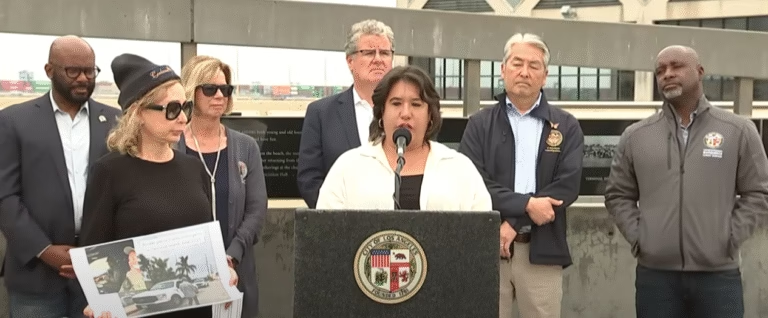I arrived at a gathering at the foot of Sixth Street in San Pedro, the Friday before Independence Day, which was held at the same time as the Stars and Stripes event just down the boulevard. This was a protest demanding that ICE leave their encampment at the U.S. Coast Guard base on Terminal Island (on some maps it’s still called East San Pedro).
What was curious is that this protest was organized by the Nikkei Progressives, a group of young Japanese Americans who have a keen understanding of how some of their ancestors were rounded up during WWII and sent to internment (concentration) camps much like the immigrants that are being rounded up today — with force of arms backed by the power of the federal government. Today, this government is making the same historical mistake, and it is wrong! This time there is an uprising of resistance.
Some 300 neighbors from the local community showed up, UTLA teachers, nurses and even a couple of local lawyers. And then two politicians. I find it curious that there was this organic outpouring of resistance, particularly in this town that is all about waving the flag, honoring veterans, and saying the Pledge of Allegiance — something is happening. It felt like an awakening. It is what’s simmering all across Los Angeles in response to the Orange Felon’s racist immigration roundups. They’re even using horses down at MacArthur Park, will lassos come next?
What’s even more enlightening is that on the Nextdoor App, which is supposed to be all about everything local, users are now connecting what’s happening on the national and regional level to what’s happening right here in their neighborhoods. This is what I have been telling people for the last four decades: you can’t separate international trade, pollution in the harbor, labor struggles, and the rest from you and your neighbors. It’s all one thing, and we are all in it together in San Pedro, this is one of the biggest bowls of migrant cioppino in the nation.
Everybody knows, even though the MAGA believers still deny it, that this is nothing about making America Great or even safe — this is a form of fascist terrorism with armed face-masked kidnappers roaming our neighborhoods, streets and places of business. In certain parts of Southern California, business districts have become ghost towns, shops closed, restaurants short-staffed, and where’s my tamale man this week?
The actions of this administration have become an existential threat to the economy, the ports (through stupid tariffs), and the threats to civil society. This is like pre-World War Germany. Are we going to have to start hiding Jews and Mexicans alike?
Because of these economic threats, even conservative chambers of commerce cannot defend these horrendous actions. Certain hotels have refused to house federal agents out of fear that their workers might get caught up or refuse to work. What will happen to the tourist industry and the long-held dream of West Harbor or the theme parks without Latinos showing up to work or buying? For it has become self-evident that you only need to look brown to be apprehended, kidnapped without a warrant and incarcerated. This, however, is just the beginning if you aren’t a loyal MAGA fascist.
And America stands divided much like it did before the Civil War. Curiously, we are still fighting each other over who is and who isn’t a citizen and whether our laws pertain to all people equally. Civil constitutional rights are not only for citizens but for everyone in the jurisdiction of our laws. This is the part where “We hold these truths to be self-evident, that all men are created equal” matters more than rockets’ red glare.
You’ve probably already heard that the law being used to have federal officers round up immigrants is the same 147-year-old law that was used to catch runaway slaves. Who would have thought this was even in the books? And now in the July 4th BIG BAD BUDGET BILL that the Orange Felon signed, there’s another $47 billion for border security and enforcement.
It has been said by many that Los Angeles is just the testing ground for how much they can actually get away with. Gov. Gavin Newsom, LA Mayor Karen Bass, and all the other political leaders are right to sue the feds, but that is simply not enough. The protestors in the streets, the civilian surveillance teams of ICE, and average citizens who are showing up are probably the most patriotic expression for this anniversary of our independence — for what was that declaration for? It was to overthrow a tyrant king who used his military to enforce obedience to the crown.
I have been going out every morning and listening to the sounds of this town, this harbor, and the silence is defining. Since the tariffs, there have been few ships in the Main Channel, and port workers have been struggling. It’s the sound of the local economy grinding to a stop. It’s very much like the dystopian vision of Paul Simon’s Sounds of Silence.
“People talking without listening … the signs of the prophets are written on the subway walls.” This is our dystopian reality, and it’s here and now. Will enough Americans wake up before it’s literally too late?
There are many still more absorbed in their own personal melodramas, petty personal politics at neighborhood councils, and ignoring the threat that is right at the doorstep. The Orange Felon is shredding the constitution, covering fascism with our flag while carrying a cross to promote white Christian nationalism, which has nothing to do with Christianity and everything to do with white racism.
These are the times that try men’s (and women’s) souls. Stand up and resist!












